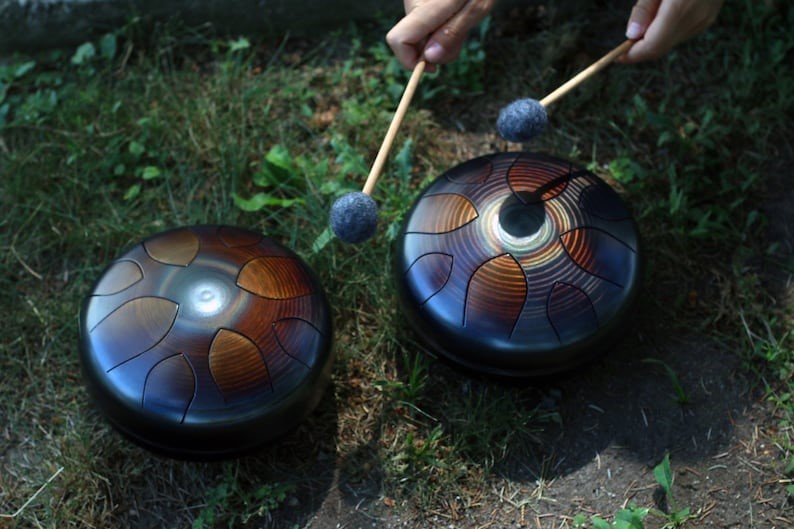Introduction
Throughout human history, music has been an integral part of our cultural expression and communication. Over time, musical instruments have evolved and diversified, reflecting the creativity and ingenuity of musicians and artisans. Among the fascinating developments in recent years are the handpan and steel tongue drum, two unique percussive instruments with ethereal and captivating sounds. In this blog post, we'll explore the evolution of these instruments, their origins, and how they have carved a special place in the world of music.
- The Handpan: A Modern Marvel
The handpan, also known as the hang drum, is a relatively recent addition to the world of musical instruments. Developed in the early 2000s by Felix Rohner and Sabina Schärer of PANArt in Switzerland, the handpan was inspired by the Trinidadian steelpan and other traditional instruments. Made from two convex steel hemispheres fused together, the handpan features a series of carefully tuned notes arranged in a circular pattern.
The mesmerizing and haunting sound of the handpan is created by striking the notes with the fingers, creating a captivating and resonant melody. Its popularity quickly spread among musicians and enthusiasts, making it a sought-after instrument for its expressive range and meditative qualities.

- Steel Tongue Drum: The Evolution Continues
The steel tongue drum, often referred to as a tank drum or hank drum, is a direct descendant of the handpan. It was created to address the high demand for handpans and the challenges associated with their intricate manufacturing process. The steel tongue drum retains the captivating sound of the handpan but is more accessible and easier to produce.
The instrument consists of a flat steel surface with tongues of varying lengths and sizes carefully cut into the metal. When played with the hands or mallets, each tongue produces a distinct pitch, allowing musicians to create beautiful melodies and rhythmic patterns. Steel tongue drums are available in various scales and tunings, offering a wide array of sonic possibilities.
- Handpan vs. Steel Tongue Drum: Differences and Similarities
While the handpan and steel tongue drum share similarities in sound and playing technique, there are some notable differences between the two instruments. Handpans have a more complex construction with a unique central note, called the "ding," and a specific arrangement of notes around it. Steel tongue drums, on the other hand, feature a simpler design with tongues evenly spaced on the surface.
Handpans tend to be more expensive and challenging to acquire due to their limited production and high demand. Steel tongue drums offer a more affordable alternative without compromising on the enchanting sound and expressive qualities. Both instruments are played with the hands or mallets and have gained popularity for their therapeutic and meditative effects.
- The Global Impact and Cultural Significance
The handpan and steel tongue drum have transcended geographical boundaries, capturing the hearts of musicians and audiences worldwide. These instruments are now embraced in various musical genres, including ambient, world, and contemporary music. They have also found a place in sound healing practices, meditation sessions, and yoga classes, where their soothing and tranquil sounds promote relaxation and introspection.
Furthermore, these instruments have sparked communities of passionate players and makers, fostering a culture of creativity and innovation. Artisans around the world have embraced the challenge of crafting these instruments, adding their unique touches to the design and sound. Workshops and festivals dedicated to handpans and steel tongue drums have become gathering grounds for enthusiasts to share their love for these instruments and explore their potential further.
- The Future of Ethereal Music
As music continues to evolve, the handpan and steel tongue drum exemplify the fusion of traditional craftsmanship with contemporary innovation. These instruments have proven that enchanting and ethereal sounds can emerge from unexpected places, captivating audiences and inspiring new forms of musical expression.
The future of these instruments lies in the hands of musicians, artisans, and enthusiasts who continue to push the boundaries of sound and creativity. As technology advances, new materials and production techniques may shape the evolution of handpans and steel tongue drums, while preserving their intrinsic beauty and emotional resonance.
Conclusion
The journey from the handpan to the steel tongue drum represents a remarkable evolution in the world of musical instruments. From the intricate craftsmanship of the handpan to the accessible and versatile steel tongue drum, both instruments have carved a unique niche in contemporary music and sound healing practices. Their enchanting melodies and meditative qualities have touched the hearts of musicians and audiences worldwide, fostering a global community of passionate players and makers. As we look ahead, the future of these ethereal instruments remains promising, continuing to inspire and captivate generations of music lovers with their soul-stirring sounds.

 WENZHOU AILIFERO DRUM CO.,LTD.
WENZHOU AILIFERO DRUM CO.,LTD.